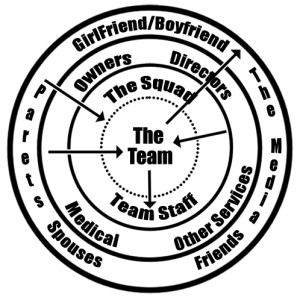
The Team Bubble
September 30, 201300Coaching, Featured news, General, Youth SoccerTags: bubble, byte size coaching, coach, football, leaders, leadership, player development, players, pro level, skill development, skills, soccer, soccer coach, teacher, team, Team Bubble, team development, team performance, volunteer coach, youth soccerSo what is the Team Bubble?
The Team Bubble is the inner sanctum within which a team produces the environment that affects the total team performance – negatively or positively. My main experience at that time was at the pro level and it was in that context I would discuss the factors that could affect the dynamics of the “Bubble.”
As you can well imagine, the pressures within a professional team are considerable. The players are in the public eye. The necessity to win games – or a least, not lose – brings about pressure that can easily cause sub performance.
It goes without saying that a coach should do everything possible to preserve team unanimity in order to be able to maximize the performance of the individuals.
So what’s the problem? Well first of all, it is important that the 11 starting players are heading in the same direction and playing together. Subgroups within the team may well be dysfunctional. 11 people working together is not the norm. Military squads rarely have as many as 11. Most squads have around six to eight. For numbers to be effective in battle most armies would not choose to have 11 in a squad. It is a bit unwieldy.
And then there are the substitutes. You think all of them a happy about riding the pines? Maybe a young up-and-comer could be quite happy to be sat on the bench, but an old pro might be very disenchanted. And then there are the players on the roster who are not even making the subs bench – never mind the starting 11. Are they working for or against the team performance?
There are many other factors and people that come into the Team Bubble. The coach is perhaps, the most important one, but also the assistant coaches, trainers and other support staff bring their own dimension to the Team Bubble. If, for whatever reason, the support staff haven’t bought into the team concept and are not actively engaged in bettering the team performance, they can poison the environment.
While the coach must do everything to preserve the spirit of the bubble, he/she cannot lock the players in the locker room between games and practices. They ha ve to move in and out of the Team Bubble and live in the “real” world. More about that later.
ve to move in and out of the Team Bubble and live in the “real” world. More about that later.
So in the bubble
there are other “part-timers” who come in and out and bring with them their own influences and changes to the environment. The media would be one of them. The Club Doctor another. Or it could be the owner of the franchise. All of these people can have a positive or detrimental effect to the bubble.
So what we’ve been talking about so far, all influence in different degrees the inner sanctum – the team.
But there are some outside influences that may not actually physically penetrate the team bubble, but will have an enormous effect on the dynamics of the inner sanctum – wives and girlfriends/boyfriends (hopefully one per player). The influence of parents and friends will all have a positive or negative effect on the inner effectiveness of the team.
So-called friends can have a real detrimental effect on players. Professional sports people are usually idolized by some and diverted in the wrong direction. They may be encouraged to party. Of course, there is a time and place for that, too! But “friends” may have little regard for that.
I haven’t mentioned yet the enormous influence of today’s sports agent. They weren’t as prevalent in my playing days and not too much in my professional coaching days, but they are do have a positive or negative effect on their clients.
So all the factors that we’ve been talking about above affect the chemistry of the team and the coach has got to try to maximize the team potential.
Looking at youth soccer, many of the factors that we’ve considered above are not present, but I’m sure as you read this article your mind has been working overtime. For instance, the coach of a U14 soccer team – boys or girls – will know the factors that he or she has to contend with — parents, girlfriends, boyfriends and so forth.
So that is the Team Bubble and I thank Steve Darby for reminding me about the concept. It really helped me in my team coaching days in tweaking the team dynamics to produce a positive team performance.
I used the word “bubble” deliberately as most bubbles can be easily burst. The coach is usually the glue that keeps the bubble intact.

